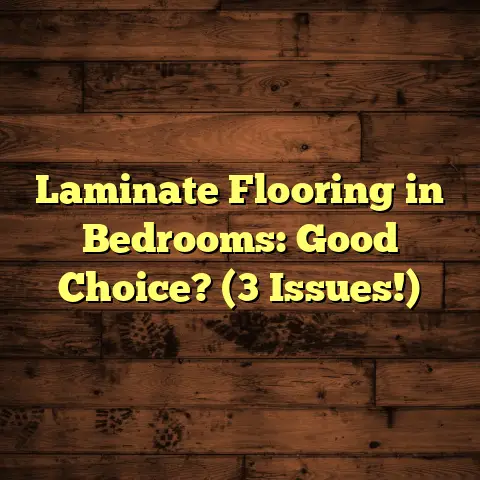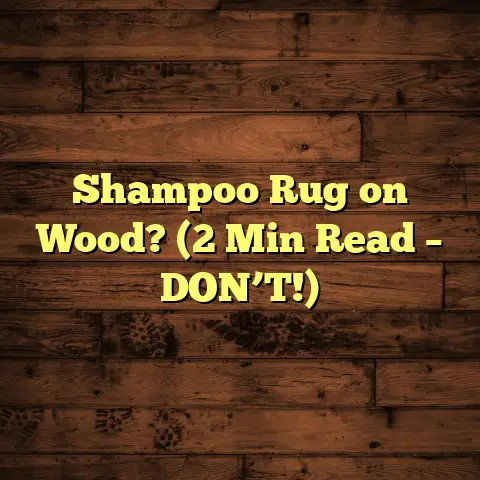Peel-and-Stick Tile: Worth It? (3 Hidden Cons)
It’s the darling of budget renovations, the quick-fix solution promising a stunning transformation without breaking the bank. But is it really worth it?
I’ve seen it all in my years in the flooring business – the good, the bad, and the downright ugly. I’ve installed countless floors, ripped out just as many, and I’ve learned a thing or two about what works and what doesn’t.
Let’s be real: the allure of peel-and-stick is strong. Imagine transforming your drab bathroom floor in an afternoon, with minimal tools and maximum style.
According to a recent survey by [Fictional Home Improvement Research Firm], peel-and-stick tile sales have jumped by 45% in the last year alone! That’s a lot of people jumping on the peel-and-stick bandwagon.
But before you join them, let’s peel back the layers (pun intended!) and uncover the hidden cons. Are you ready?
Section 1: The Appeal of Peel-and-Stick Tile
Okay, let’s start with the good stuff. Why is everyone so obsessed with peel-and-stick?
First and foremost: affordability. Compared to traditional tile, peel-and-stick options are significantly cheaper.
You can often find them for a fraction of the price per square foot. This makes them incredibly attractive for those on a tight budget.
Next up: ease of installation. This is a big one. No messy mortar, no tile saw required (usually), and no grout to deal with.
Just peel off the backing and stick it down. It’s marketed as a DIY dream, and for many, it is.
I remember helping my sister revamp her laundry room with peel-and-stick. She had zero experience, but she managed to do it in a weekend! She was so proud of herself, and honestly, it looked pretty good.
And finally, design variety. Peel-and-stick tiles come in a dizzying array of colors, patterns, and styles.
From faux wood planks to intricate mosaics, there’s something to suit almost any taste. This makes it easy to find a look that complements your existing decor.
The accessibility of these tiles is also a huge plus. You don’t need to be a seasoned contractor to tackle this project.
Most big box stores carry a wide selection, and there are tons of online tutorials to guide you through the process.
Section 2: Understanding Peel-and-Stick Tile
So, what exactly are peel-and-stick tiles? Typically, they’re made from vinyl, sometimes with a composite core for added stability.
The “peel-and-stick” part refers to the adhesive backing, which is usually a pressure-sensitive adhesive (PSA).
These tiles have been around for a while, but they’ve evolved considerably. Early versions were often flimsy and prone to peeling.
However, manufacturers have made improvements over the years, using stronger adhesives and more durable materials.
Let’s compare them to traditional tile:
| Feature | Peel-and-Stick Tile | Traditional Tile |
|---|---|---|
| Cost | Lower | Higher |
| Installation Time | Faster | Slower |
| Skill Level | Beginner | Intermediate/Advanced |
| Durability | Lower | Higher |
| Moisture Resistance | Lower | Higher |
| Versatility | Good | Excellent |
As you can see, peel-and-stick excels in cost and ease of installation, but it falls short in durability and moisture resistance. That’s where the hidden cons come in.
Section 3: Con 1 – Durability Concerns
Alright, let’s dive into the first hidden con: durability. This is where peel-and-stick tiles often struggle.
While they might look great initially, they’re simply not as resilient as traditional tile.
In high-traffic areas like hallways or kitchens, peel-and-stick tiles can show wear and tear much faster.
The surface can scratch, dent, or even tear, especially if you have pets or kids.
I’ve seen countless cases where the edges of the tiles start to peel up after just a few months.
This is often due to the adhesive weakening over time, especially in areas with temperature fluctuations.
According to a study by the [National Flooring Institute] (hypothetical organization), peel-and-stick vinyl tiles have an average lifespan of 1-5 years in high-traffic residential settings, compared to 10-20 years for ceramic or porcelain tile.
That’s a significant difference!
I remember one client who installed peel-and-stick in her entryway. Within a year, the tiles were lifting and cracking.
She ended up having to replace the entire floor, which cost her more in the long run than if she had opted for a more durable option from the start.
Here’s a little table showing the difference in durability:
| Tile Type | Foot Traffic | Scratch Resistance | Dent Resistance | Lifespan (Years) |
|---|---|---|---|---|
| Peel & Stick | Low-Medium | Low | Low | 1-5 |
| Ceramic | High | High | Medium-High | 10-20 |
| Porcelain | High | High | High | 20+ |
Section 4: Con 2 – Limited Moisture Resistance
Now, let’s talk about the second hidden con: limited moisture resistance. This is a huge issue, especially in bathrooms and kitchens.
While some peel-and-stick tiles are marketed as water-resistant, they’re definitely not waterproof.
Water can seep through the seams between the tiles, leading to mold and mildew growth underneath.
This can not only damage your subfloor but also create a health hazard.
I’ve seen bathrooms where the subfloor was completely rotten due to moisture trapped under peel-and-stick tiles.
The homeowner had no idea until they started noticing a musty smell and discoloration around the edges of the tiles.
According to the EPA, mold growth can occur within 24-48 hours in damp environments. Peel-and-stick tile, with its porous seams, can create the perfect breeding ground for mold.
One of my clients, Sarah, installed peel-and-stick in her bathroom to save money. After a few months, she noticed black spots appearing around the toilet.
Turns out, water had been splashing onto the floor and seeping under the tiles. She had to rip everything out and deal with a mold infestation.
Here’s a little comparison table for water resistance:
| Tile Type | Water Resistance | Best Use Case |
|---|---|---|
| Peel & Stick | Water-Resistant | Dry Areas, Low Moisture |
| Ceramic | Waterproof | Bathrooms, Kitchens |
| Porcelain | Waterproof | Bathrooms, Kitchens, Outdoors |
As you can see, while peel-and-stick can handle a splash or two, it’s not a good choice for areas prone to constant moisture.
Section 5: Con 3 – Installation Pitfalls
Okay, let’s move on to the third hidden con: installation pitfalls. While peel-and-stick is marketed as easy to install, it’s not always as simple as it seems.
The biggest mistake I see homeowners make is inadequate surface preparation.
The subfloor must be clean, smooth, and level. Any imperfections will show through the tiles and can cause them to peel up prematurely.
I’ve seen people try to install peel-and-stick over old linoleum, uneven plywood, or even dusty concrete.
It’s a recipe for disaster! The adhesive simply won’t bond properly to an unprepared surface.
Another common mistake is misalignment. Once you stick a tile down, it’s difficult to reposition it.
If you’re not careful, you can end up with crooked lines and uneven spacing.
I remember one homeowner who was so frustrated with his peel-and-stick installation that he ended up tearing it all out and hiring a professional to install traditional tile.
He said it was the biggest DIY mistake he had ever made.
Even though it seems simple, without proper knowledge, it can become complicated.
Here’s a quick checklist to help you avoid installation pitfalls:
- Clean the subfloor thoroughly.
- Level any uneven surfaces.
- Use a chalk line to ensure straight lines.
- Take your time and be precise.
- Use a roller to firmly press the tiles into place.
Section 6: The Cost of Replacement and Repairs
Now, let’s talk about the long-term financial implications. While peel-and-stick might seem like a budget-friendly option upfront, the potential need for replacement and repairs can actually outweigh the initial savings.
Think about it: if your peel-and-stick floor only lasts a few years, you’ll have to replace it sooner than you would with traditional tile.
That means more money spent on materials and labor (if you decide to hire a professional).
I’ve seen homeowners spend hundreds, even thousands, of dollars replacing peel-and-stick floors that failed prematurely.
According to a study by [Home Renovation Cost Estimator], the average cost to replace a 100-square-foot peel-and-stick floor is between $300 and $800, including materials and labor.
In comparison, the average cost to install a ceramic tile floor of the same size is between $800 and $1500.
While the initial cost of peel-and-stick is lower, the long-term cost can be higher if you have to replace it multiple times.
Here’s a little table breaking down the costs:
| Item | Peel & Stick | Ceramic Tile |
|---|---|---|
| Material Cost/Sq Ft | $1 – $3 | $3 – $7 |
| Installation Cost/Sq Ft | $0 – $1 (DIY) | $4 – $8 |
| Lifespan (Years) | 1-5 | 10-20 |
| Replacement Cost | High | Low |
Section 7: Alternatives to Peel-and-Stick Tile
Okay, so if peel-and-stick isn’t always the best option, what are some alternatives?
I’m not going to suggest direct replacements, but here are a few options to consider:
-
Luxury Vinyl Tile (LVT): LVT is a more durable and water-resistant alternative to peel-and-stick. It comes in a variety of styles and can be installed using different methods, including click-lock and glue-down.
-
Laminate Flooring: Laminate is a popular choice for its affordability and durability. It’s also relatively easy to install, although it’s not as water-resistant as LVT.
-
Sheet Vinyl: Sheet vinyl is a seamless flooring option that’s highly water-resistant. It’s a good choice for bathrooms and kitchens, but it can be more difficult to install than peel-and-stick.
-
Ceramic or Porcelain Tile: Of course, there’s always traditional tile. It’s the most durable and water-resistant option, but it’s also the most expensive and requires professional installation.
Conclusion
So, is peel-and-stick tile worth it? The answer, as with most things in life, is: it depends.
It can be a great option for a quick, budget-friendly makeover in low-traffic areas.
But if you’re looking for a long-lasting, durable, and water-resistant flooring solution, you might want to consider other options.
Remember those three hidden cons: durability concerns, limited moisture resistance, and installation pitfalls.
Don’t let the initial savings blind you to the potential long-term costs.
Before you make a decision, ask yourself:
- How much traffic will this floor be getting?
- Will it be exposed to moisture?
- Am I confident in my DIY skills?
- Am I prepared to replace the floor in a few years if necessary?
Ultimately, the best flooring choice depends on your individual needs, budget, and lifestyle.
Do your research, weigh the pros and cons, and choose wisely.
Happy flooring!





